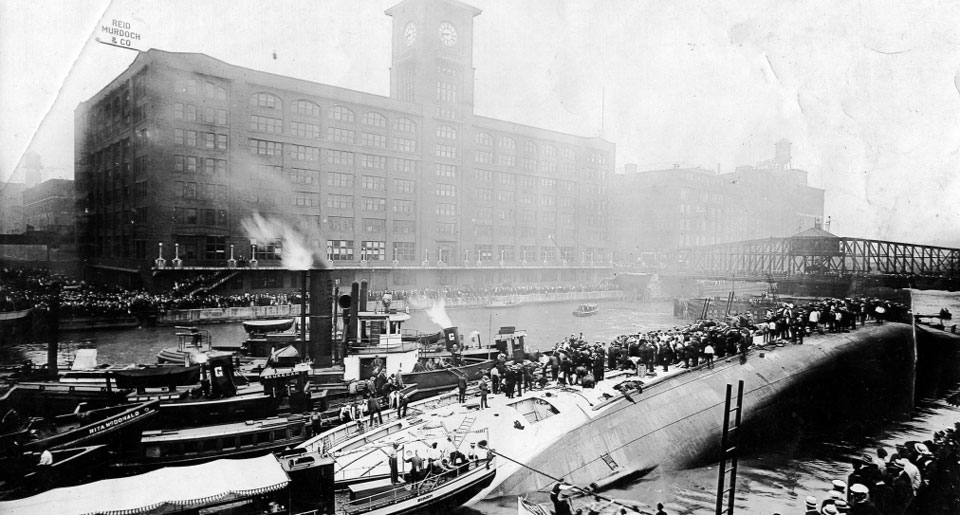
In less than one hour following the Disaster, John J. O'Connor, Director of the Central Division of the American Red Cross, was at work at the scene of the tragedy. Within a few hours, Ernest P. Bicknell, National Director of the American Red Cross, was speeding on his way from national headquarters in Washington, D. C. to Chicago. At the same time, the Red Cross established a relief station at the Hawthorne Works facility for families of victims who were not Western Electric employees.
Officials of Reid, Murdoch & Company, a wholesale grocery firm, approved the use of their building for the rescue and relief efforts. The building, located directly across the Chicago River from the scene of the accident, was untenanted on July 24, 1915 because Reid, Murdoch & Company employees were attending their annual company picnic. The basement and first floor were opened for the relief efforts. Operators quickly secured the telephone switchboard.
Those who were clinging to life were taken to the first floor for treatment. The deceased were numbered and brought into the large, cement basement where volunteer embalmers were already at work. Police carefully searched the victims' bodies for valuables and identifications, placing all papers and other articles in large envelopes.
Truckloads of stretchers, blankets and other supplies arrived from the State Street department stores offered at no charge. The alley at the rear of the building was congested with scores of trucks and delivery wagons. Each truck was unloaded, then quickly re-loaded with blanket-wrapped bodies and sent to the Second Regiment Armory which had been secured by the Coroner's office as its central morgue.
Shortly after the Coroner's office established the temporary morgue at the Armory, the Red Cross established rest rooms and first aid stations within and saw to the installation of scores of telephones. The Chicago Red Cross nurses chairperson, Miss Minnie F. Aherns, quickly selected a competent staff and provided cots and restoratives for the Armory emergency stations. The emergency stations handled dozens of fainting and hysterical people who entered the temporary morgue. Between midnight and 7 a.m., care is provided for 30 hysterical and exhausted women.
About midday, nurses and physicians were secured to relieve those who were tiring. By afternoon the strain was beginning to show on the rescuers, many of whom had been without food since early morning. Feeding stations were then established on nearby tugs and docks.
On Sunday, the day after the tragedy, the American Red Cross was still hard at work. Company and privately-owned cars are brought to and parked at the emergency relief station. As soon as cases were reported, American Red Cross relief workers left immediately to visit their designated family. Simple instructions were given to the case workers: “Give prompt relief. Ask questions next week.” Depending on the nurse's report information, each relief worker took cash, a physician, interpreter, or whatever else necessary.
The names of 500 families were distributed among nurses, and American Red Cross family worksheet cards were also given. They opened an emergency relief station at the Western Electric Company Hawthorne facility where the needs of each family was identified. The families were grouped into three categories:
Approximately $15,000 in small grants and monthly allowances for emergency needs were expended while they waited for necessary facts to distribute permanent relief funds. One week later, the American Red Cross closed its emergency relief office at the Hawthorne facility and opened its new principal office in the Conway Building across from City Hall.